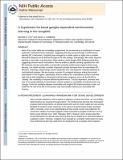A hypothesis for basal ganglia-dependent reinforcement learning in the songbird
Author(s)
Fee, Michale S.; Goldberg, Jesse H.
DownloadFee_A hypothesis for basal.pdf (3.186Mb)
PUBLISHER_CC
Publisher with Creative Commons License
Creative Commons Attribution
Terms of use
Metadata
Show full item recordAbstract
Most of our motor skills are not innately programmed, but are learned by a combination of motor exploration and performance evaluation, suggesting that they proceed through a reinforcement learning (RL) mechanism. Songbirds have emerged as a model system to study how a complex behavioral sequence can be learned through an RL-like strategy. Interestingly, like motor sequence learning in mammals, song learning in birds requires a basal ganglia (BG)-thalamocortical loop, suggesting common neural mechanisms. Here, we outline a specific working hypothesis for how BG-forebrain circuits could utilize an internally computed reinforcement signal to direct song learning. Our model includes a number of general concepts borrowed from the mammalian BG literature, including a dopaminergic reward prediction error and dopamine-mediated plasticity at corticostriatal synapses. We also invoke a number of conceptual advances arising from recent observations in the songbird. Specifically, there is evidence for a specialized cortical circuit that adds trial-to-trial variability to stereotyped cortical motor programs, and a role for the BG in “biasing” this variability to improve behavioral performance. This BG-dependent “premotor bias” may in turn guide plasticity in downstream cortical synapses to consolidate recently learned song changes. Given the similarity between mammalian and songbird BG-thalamocortical circuits, our model for the role of the BG in this process may have broader relevance to mammalian BG function.
Date issued
2011-10Department
McGovern Institute for Brain Research at MITJournal
Neuroscience
Publisher
Elsevier BV
Citation
Fee, Michale S. and Jesse H. Goldberg. "A hypothesis for basal ganglia-dependent reinforcement learning in the songbird." Neuroscience 198 (December 2011): 152-170. © 2011 IBRO
Version: Author's final manuscript
ISSN
0306-4522